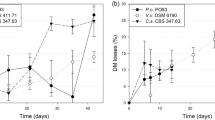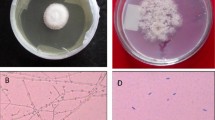Abstract
Solid waste from anaerobic digestion of litter from the commercial production of broiler chickens has limited use as fertilizer. Its disposal is a major problem for digester operators who are seeking alternative use for anaerobic digester solids, also referred to as solid waste (SW). The use of SW as substrates for the cultivation of Pleurotus ostreatus strain MBFBL400 was investigated. Lignocellulolytic enzymes activity, substrate utilization, and mushroom yield were evaluated in ten different substrate combinations (SCs) containing varying amounts of solid waste, wheat straw, and millet. Nutritional content of mushrooms produced on the different substrates was also determined. Substrates containing 70–80% wheat straw, 10–20% SW, and 10–20% millet were found to produce the highest mushroom yield (874.8–958.3 g/kg). Loss of organic matter in all SCs tested varied from 45.8% to 56.2%, which had positive correlation with the biological efficiency. Laccase, peroxidase, and carboxymethylcellulase (CMCase) activities were higher before fruiting, whereas xylanase showed higher activities after mushroom fruiting. SW increased the nutritional content in mushrooms harvested, and the combination of wheat straw and SW with millet significantly improved mushroom yield. Our findings demonstrated the possibility of utilizing anaerobic digester solids in mushroom cultivation. The application of SW as such could improve the financial gains in the overall economy of anaerobic digester plants.

Similar content being viewed by others
References
AOAC (1990) Official method of analysis. Association of official analytical chemists, 15th edn. Washington
Bailey MJ, Biely P, Poutanen K (1992) Interlaboratory testing of methods for assay of xylanase activity. J Biotech 2:257–270
Baines S (1970) Anaerobic treatment of farm wastes. In: Proceedings of the symposium on farm wastes, Institute of Water Pollution Control, paper no. 18, vol 132–137. University of Newcastle upon Tyne, UK
Balan V, da Costa Sousa L, Chundawat SPS, Vismeh R, Jones AD, Dale BE (2008) Mushroom spent straw: a potential substrate for an ethanol-based biorefinery. J Ind Microbiol Biotechnol 35:296–301
Bano Z, Rajarathnam S (1988) Pleurotus mushroom. Part II. Chemical composition, nutritional value, post-harvest physiology, preservation and role as human food. Crit Rev Food Sci Nutr 27:87–158
Banik S, Nandi R (2004) Effect of supplementation of rice straw with biogas residual slurry manure on the yield, protein and mineral contents of oyster mushroom. Ind Crops Prod 20:311–319
Bernas E, Jaworska G, Kmiecik W (2006) Storage and processing of edible mushrooms. Acta Sci Pol Technol Aliment 5:5–23
Brushwood DE (2000) Modification of potassium ferricyanide reducing sugar test for sugars from extracts of cotton fiber. J Cotton Sci 4:202–209
Chang ST, Miles PG (1984) A new look at cultivated mushroom. BioScience 34:358–362
Chung Po HH, Wong SK (1975) Small methane generator for waste disposal. In: Proceedings of the 3rd international symposium on livestock wastes, Urbana, IL. ISBN:0916150003
Crisan EV, Sands A (1978) Nutritional value. In: Chang ST, Hayes WH (eds) Biology and cultivation of edible fungi. Academic Press, New York, pp 137–168
De Groot PWJ, Visser J, Van Griensver LJLD, Schaap PJ (1998) Biochemical and molecular aspects of grown and fruiting of the edible mushroom Agaricus bisporus. Mycol Res 102:1297–1308
Derias RE (1961) Method for determination water soluble carbohydrates. JSFA 12:152
Eriksson KE, Blanchette RA, Ander P (1990) Microbial and enzymatic degradation of wood and wood components. Springer series in wood science. Springer, Berlin
Erickson LE (2000) Bioreactors. In: Lederberg J (ed) Encyclopedia of microbiology, vol 1, 2nd edn. Academic Press, New York, pp 579–586
Forsee WT (1938) Determination of reducing sugars. Ind Eng Chem Anal Ed 10:411–418
Ghose TK (1987) Measurement of cellulase activities. Pure Appl Chem 59:57–268
Ghosh M, Mukherjere R, Nandi B (1998) Production of extracellular enzymes by two Pleurotus species using banana pseudostem biomass. Acta Biotechnol 18:243–254
Glenn JK, Gold MH (1985) Purification and characterization of an extracellular Mn(II)-dependent peroxidase from the lignin-degrading basidiomycete Phanerochaete chrysosporium. Arch Biochem Biophys 242:329–341
Hernández D, Sánchez J, Yamasaki K (2003) A simple procedure for preparing substrate for Pleurotus ostreatus cultivation. Bioresour Technol 90:145–150
Isikhuemhen OS, Nerud F (1999) Preliminary studies on the ligninolytic enzymes produced by the tropical fungus Pleurotus tuberregium (Fr.) Sing. Antonie Van Leeuwenhoek 75:257–260
Isikhuemhen OS, Mikiashvili NA, Kelkar V (2008) Application of solid waste from anaerobic digestion of poultry litter in Agrocybe aegerita cultivation: mushroom production, lignocellulolytic enzyme activity and substrate utilization. Biodegradation: 20:351–361
Kues U, Liu Y (2000) Fruiting body production in basidiomycetes. Appl Microbiol Biotechnol 54:141–152
Liedl BE, Bombardiere J, Chatfield JM (2006) Fertilizer potential of liquid and solid effluent from thermophilic anaerobic digestion of poultry waste. Water Sci Technol 53:69–79
Madan M, Vasudevan P, Sharma S (1987) Cultivation of Pleurotus sajur-caju on different wastes. Biol Wastes 22:241–250
Madelin MF (1956) Studies on the nutrition of Coprinus lagapus Fr, especially as affecting fruiting. Ann Bot 20:467–480
Manzi P, Gambelli L, Marconi S, Vivanti V, Pizzoferrato L (1999) Nutrients in edible mushroom: an interspecies comparatively study. Food Chem 65:477–482
Nicolini L, Von Hunolstein A, Carilli A (1987) Solid state fermentation of orange peel and grape stalks by Pleurotus ostreatus, Agrocibe aegerita and Armillariella mellea. Appl Microbiol Biotechnol 26:95–98
NIIR Board of Consultants and Engineers (2006) Handbook of mushroom cultivation and processing. chemical composition, antinutritional factors and shelflife of oyster mushroom (Pleurotus ostreatus). Asia Pacific Business Press Inc. Delhi, pp 63–69
Noble R, Hobbs PJ, Mead A, Dobrovin-Pennington A (2002) Influence of straw types and nitrogen sources on mushroom composting emissions and compost productivity. J Ind Microbiol Biotechnol 29:99–110
Ohga S, Smith M, Trurston C, Wood DA (1999) Transcriptional regulation of laccase and cellulose genes in the micelium of Agaricus bisporus during fruit body development on a solid substrate. Mycol Res 103:1557–1560
Ohga S, Cho NS, Thurston CF, Wood DA (2000) Transcriptional regulation of laccase and cellulase in relation to fruit body formation in the mycelium of Lentinula edodes on a sawdust-based substrate. Mycoscience 41:149–153
Philippoussis A, Zervakis G, Diamantopoulou P (2001) Bioconversion of agricultural lignocellulosic wastes through the cultivation of the edible mushroom Agrocybe aegerita, Volvariella volvacea and Pleurotus spp. World J Microbiol Biotechnol 17:191–200
Poutanen K, Puls J (1988) Characteristics of Trichoderma reeseiβ-xylosidase and its use in the hydrolysis of solubilized xylans. Appl Microbiol Biotechnol 28:425–432
Rajarathnam S. (1981) Studies on the pathological and biochemical aspects during cultivation and storage of the mushroom Pleurotus flabellatus. PhD. Thesis, University of Mysore, Mysore
Rajarathnam S, Wankhede DB, Bano Z (1987) Degradation of rice straw by Pleurotus flabellatus. J Chem Technol Biotechnol 37:203–214
Rangaswami F, Kandaswami TK, Ramasamy K (1975) Pleurotus sajor-saju (Fr.) Singer, a protein rich nitrogen fixing mushroom fungus. Curr Sci 44:403–404
Singh A, Abduilah N, Vikineswary S (2003) Optimization of extraction of bulk enzymes from spent mushroom compost. J Chem Technol Biotechnol 78:743–752
Stafford DA, Hawkes DL, Horton RH (1980) Methane production from waste organic matter. CRC Press, Boca Raton
STFC (1982) Standard tables of food composition in Japan. In: Resources Council, Science and Technology Agency, Japan (eds) Tokyo: Printing Office of the Ministry of Finance, 4th revised edn, p 707
Terashita T, Murao R, Yoshikawa K, Shishiyama J (1998) Changes in carbohydrase activities during vegetative growth and development of fruit-bodies of Hypsizygus marmoreus grown in sawdust-based culture. J Wood Sci 44:234–236
Thompson DN, Houghton TN, Lacey JA, Peter G, Shaw PG, Hess R (2003) Preliminary investigation of fungal bioprocessing of wheat straw for production of straw-thermoplastic composites. Appl Biochem Biotech 106:423–436
Tshinyangu KK (2006) Effect of grass hay substrate on nutritional value of Pleurotus ostreatus var. columbinus. Food 40:79–83
Valmaseda M, Martínez MJ, Martínez A (1991) Kinetics of wheat straw solid-state fermentation with Trametes versicolor and Pleurotus ostreatus—lignin and polysaccharide alteration and production of related enzymatic activities. Appl Microbiol Biotechnol 35:817–823
Van Soest PJ, Pobertson JB, Lewis BA (1991) Methods for dietary fiber, neutral detergent fiber and nonstarch polysaccharides in relation to animal nutrition. J Dairy Sci 74:3583–3597
Wang D, Sakoda A, Suzuki M (2001) Biological efficiency and nutritional value of Pleurotus ostreatus cultivated on spent beer grain. Bioresour Technol 78:293–300
Zhang R, Li X, Fadel JG (2002) Ouster mushroom cultivation with rice and wheat straw. Bioresour Technol 82:277–284
Acknowledgments
This research was supported by USDA grants entitled “Organic Waste Treatment Using Thermophilic Anaerobic Digestion (Bioplex) Phase 5 (grant #2005-38850-02292)” and the WVSU Gus R. Douglass Land-Grant Institute of Agricultural, Consumer, Environmental and Outreach Programs. We are grateful to Monica Haddix for help with statistical analysis, Eric Lopez for experimental work, David LeBauer and the North Carolina A&T Agricultural Research program for technical review, and to the Ag Communications team at NC A&T State University for editorial review.
Author information
Authors and Affiliations
Corresponding author
Rights and permissions
About this article
Cite this article
Isikhuemhen, O.S., Mikiashvilli, N.A. Lignocellulolytic enzyme activity, substrate utilization, and mushroom yield by Pleurotus ostreatus cultivated on substrate containing anaerobic digester solids. J Ind Microbiol Biotechnol 36, 1353–1362 (2009). https://doi.org/10.1007/s10295-009-0620-1
Received:
Accepted:
Published:
Issue Date:
DOI: https://doi.org/10.1007/s10295-009-0620-1




